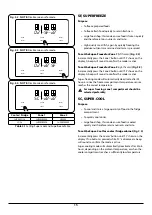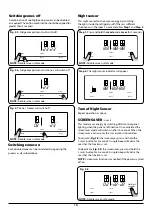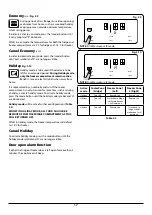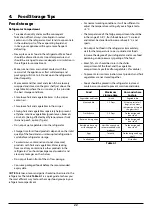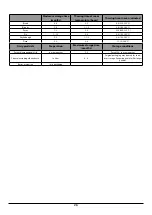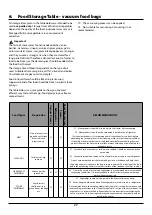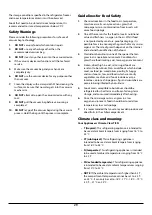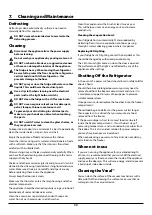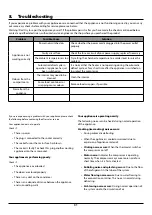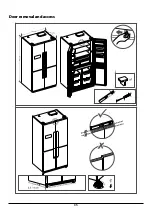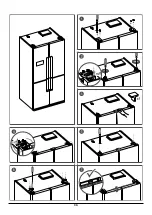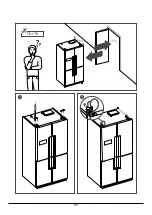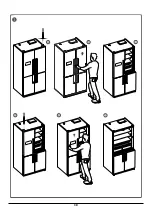
29
The storage conditions specified in the refrigerator, freezer
and room temperature columns must be observed.
Foods that need to be stored at room temperature, It is
recommended to store at temperatures below 20 °C.
Safety Warnings
Please consider the following precautions for safe use of
vacuum bag technology.
1.
DO NOT
vacuum food which contains liquids.
2.
DO NOT
use any other bags other than the
recommended vacuum bag.
3.
DO NOT
insert any other tools into the vacuum device.
4.
If the vacuum device malfunctions, call the technical
service.
5.
Make sure the vacuum bag and your hands are
completely dry.
6.
DO NOT
use the vacuum device for any purpose other
than vacuum.
7.
Clean the display with a damp cloth. When cleaning the
surface, make sure that no water gets into the vacuum
mechanism.
8.
DO NOT
attempt to open the vacuum device with any
tool.
9.
DO NOT
pull the vacuum bag before vacuuming is
completed.
10. DO NOT
let go of the vacuum bag during the vacuum
process. Hold the bag until the process is complete.
Guidelines for Food Safety
1.
Chemical reactions in the food to air, temperature,
moisture as well as enzyme actions, growth of
microorganisms or contamination from insects will
cause food spoilage.
2.
One of the reasons for the food to lose its nutritional
value and freshness is oxygen in the air. Whilst food
is not protected by moisture-proof packagings, it is
possible for air to encourage the growth of many micro-
organisms. The rate of growth depends on the internal
and external humidification of the food.
3.
Clostridium botulinum is one of the species that can
grow in an anaerobic environment. Conditions for
growth are foods lacking acid, low oxygen environment.
4.
Frozen, dried, high in acid, salt or sugar foods are
resistant to botulinum. Non-acidic foods which include
meat, seafood, lye-cured olives, poultry, fish, eggs
and mushrooms; low-acid foods which are mostly
vegetables; medium-acid foods include overripe
tomatoes, onions, chili peppers, figs and cucumbers are
prone to being infected by botulinum.
5.
Foods most susceptible to botulinum should be
refrigerated for short term and frozen for long-term
storage, and consumed immediately after heating.
6.
Since the micro-organisms can grow in a low
oxygen environment, foods should be stored at low
temperatures to avoid spoilage.
7.
It is recommended that you store your deli produce and
dried fruits in the chiller compartment.
Climate class and meaning:
Your Appliance is Climate Class T/SN
• T (tropical):
This refrigerating appliance is intended to
be used at ambient temperatures ranging from 16 °C to
43 °C.
• ST (subtropical):
This refrigerating appliance is
intended to be used at ambient temperatures ranging
from 16 °C to 38 °C.
• N (temperate):
This refrigerating appliance is intended
to be used at ambient temperatures ranging from 16 °C
to 32 °C.
• SN (extended temperate):
This refrigerating appliance
is intended to be used at ambient temperatures ranging
from 10 °C to 32 °C.
• NOTE
: If the ambient temperature is higher than 42 °C,
the compartment temperature cannot be set to -23 °C
or -24 °C. It can only be set to -16°C, -17°C, -18 °C, -19 °C,
-20 °C, -21 °C or -22 °C.
Summary of Contents for ASXSDL21 Deluxe
Page 2: ......
Page 38: ...35 Door removal and access...
Page 39: ...36...
Page 40: ...37...
Page 41: ...38...
Page 42: ...39...
Page 43: ...40...
Page 50: ...47 910 1850 1019 758 750 800 7 1136 5 1625 1 1157 8 140o 120 o 140o 120 o...

